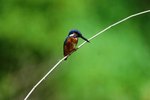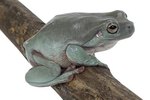
Arboreal animals are creatures who spend the majority of their lives in trees. They eat, sleep and play in the tree canopy. There are thousands of species that live in trees, including monkeys, koalas, possums, sloths, various rodents, parrots, chameleons, geckos, tree snakes and a variety of insects. Many animals have evolved special adaptations to aid their arboreal lifestyles.
Limbs and Tails
Many arboreal animals have elongated limbs that allow them to swing efficiently from branch to branch. Many monkey species show this anatomical adaptation. Several creatures have long tails -- called prehensile tails -- that can grasp branches and act as an extra limb. Spider monkeys, possums and chameleons are examples of animals that use their tails to help move and stabilize themselves in the tree canopy.
Feet and Claws
It is important that animals living in trees can grip well. Some arboreal animals, like squirrels, have ankle joints that are highly flexible, allowing the foot to point backwards so claws can hook into the tree bark when they are coming down the tree. Many arboreal animals have claws to grip into the trees, while others have adhesive pads like tree frogs and geckos. Primates have hairless fingertips for gripping, and chameleons have mitten-like feet to grasp branches.
Movement
Moving through trees presents different challenges to moving on the ground. Arboreal species tend to have a low center of mass to minimize the chance of toppling when climbing, and some have a crouched posture. They tend to have a diagonal sequence gait to maximize balance. Most arboreal mammals extend their limbs further forward and backward during movement, taking longer steps than their non-arboreal counterparts.
Size
The size of an arboreal animal influences the places it can go. Smaller animals can move through more cluttered habitat and can access smaller branches that will not take the weight of bigger animals. This can be an advantage in food gathering. Size and weight are also important for animals who use a gliding motion to move from tree to tree. Small species like bats often hang from branches, but so can larger animals like sloths, which achieve stability by hanging from their powerful claws.
References
Resources
Photo Credits
-
Anup Shah/Photodisc/Getty Images




